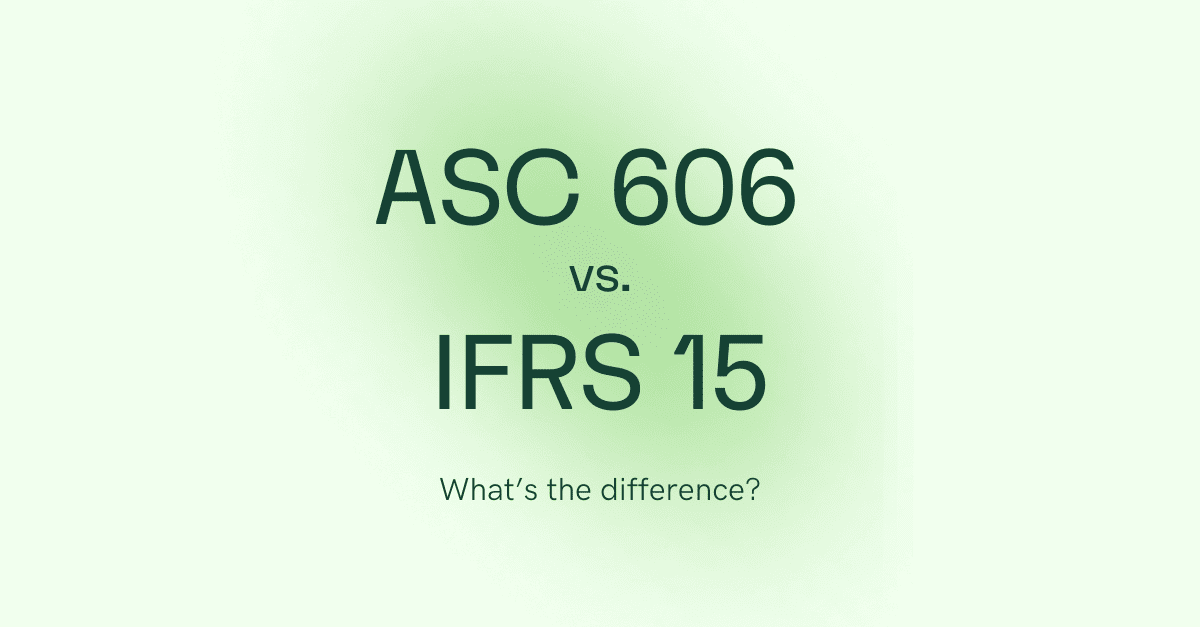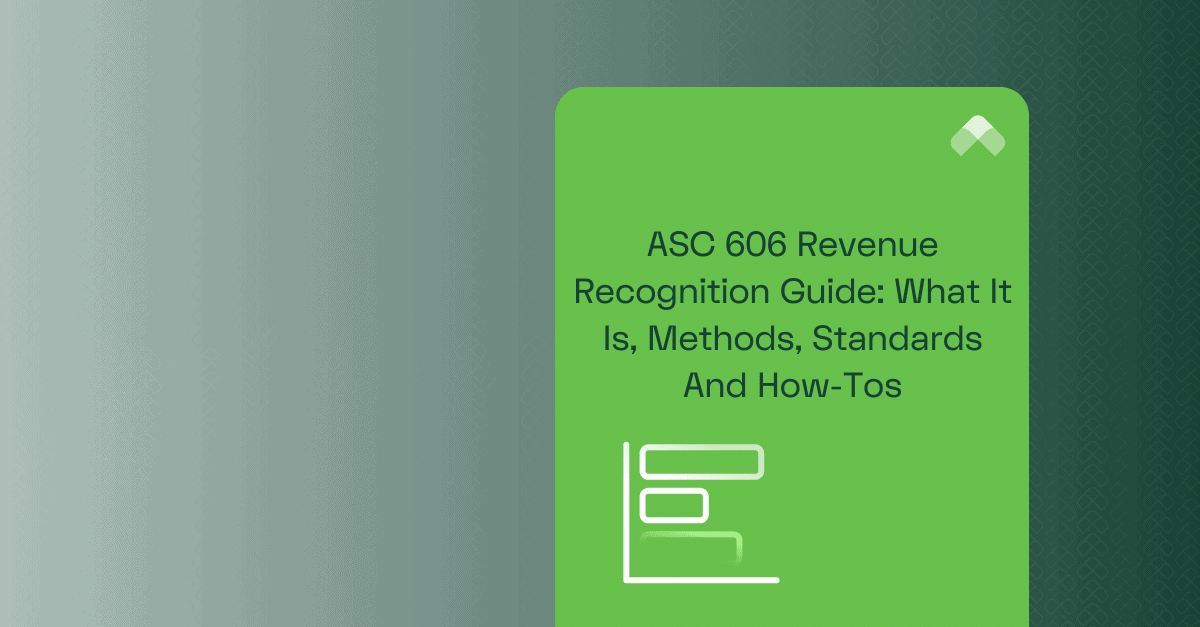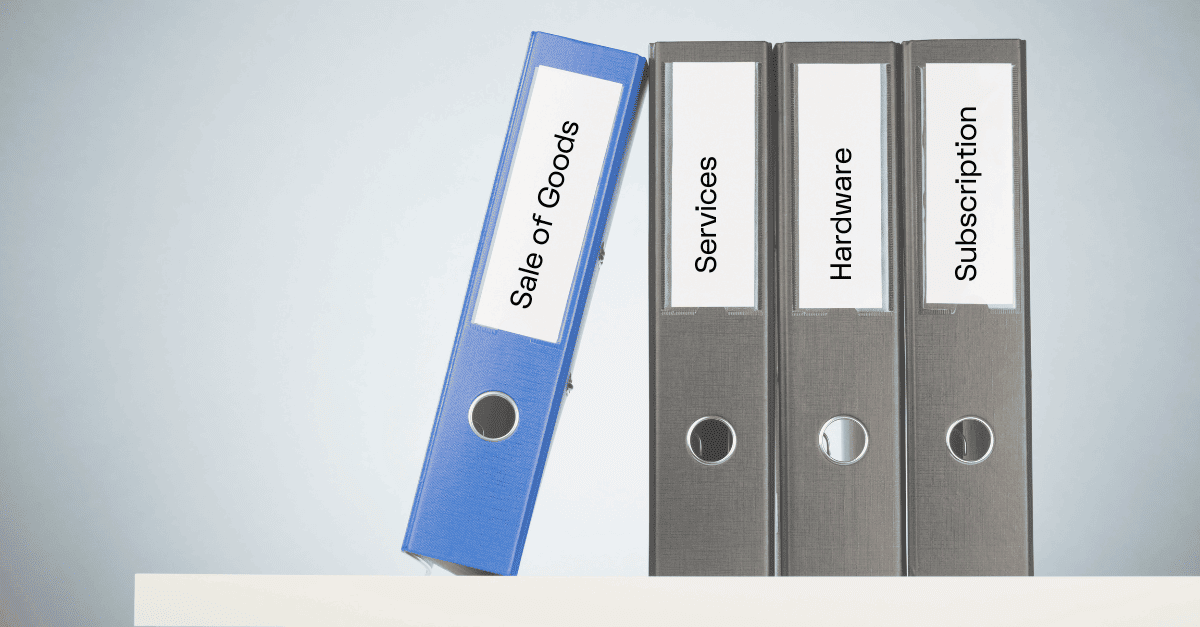The way a company’s accounting team recognizes revenue naturally impacts how its performance appears in its financial statements. In the past, prior to the introduction of industry standards ASC 606 and IFRS 15, revenue recognition varied widely between industries, making it hard for investors and others to compare the financial health of various businesses.
In May 2014, the Financial Accounting Standards Board (FASB) issued ASC 606 in the United States with the International Accounting Standards Board (IASB), issuing IFRS 15 for many other countries, including the European Union. Since then, these two accounting standards have become the cornerstones shaping how business entities worldwide recognize revenue.
Together, ASC 606 and IFRS 15 promote transparency and consistency across global markets. The guidance and frameworks they provide aim to standardize the practice of revenue recognition, helping to create harmony and clarity despite all the differences between various industries.
Despite their shared objectives, however, the two standards aren’t completely identical. There are nuanced variations between them that affect how businesses account for their revenue streams. Companies must clearly understand these disparities to produce accurate financial reporting and comply with regulations.
This in-depth guide explains all the major distinctions between ASC 606 and IFRS 15 and explores their significance so businesses can move forward confidently as they recognize revenue and report on it. By following the guidance of these two industry standards, companies can improve comparability and visibility in financial reporting for investors and other stakeholders worldwide.
What Is ASC 606?
ASC 606, or Accounting Standards Codification 606, is a set of accounting principles that outlines how revenue from customer contracts should be recognized and reported in financial statements. It was issued by the Financial Accounting Standards Board (FASB) in May 2014 and is a part of the Generally Accepted Accounting Principles (GAAP) in the United States.
ASC 606 was introduced to standardize financial reporting across different industries by providing a unified framework for recognizing revenue. It became effective for public companies for fiscal years beginning after December 15, 2017, and for private companies and non-profits for fiscal years beginning after December 15, 2018.
Unlike previous revenue recognition standards under GAAP, which were arguably fragmented and varied across different locations and sectors, ASC 606 gave business entities more clarity about how and when to recognize revenue. It even went so far as to introduce a detailed five-step revenue recognition model.
In a nutshell, this framework involves identifying contracts and their performance obligations, determining and allocating transaction prices, and recognizing revenue when obligations are fulfilled.
These five steps are explained in further detail below:
- Identification of the contract with the customer: There are certain criteria that need to be met when a company enters into a contract to provide goods or services to a customer. For example, both parties must have approved the contract and are committed to fulfilling their obligations; both parties can identify the other’s rights and the payment terms; the contract is commercially substantial, and the company expects to be paid once it fulfills its obligations.
- Identification of performance obligations in the contract: A performance obligation is defined as a promise by a company to transfer goods or services to the customer. Companies must identify (and should itemize) all the distinct performance obligations within the contract. Performance obligations are considered distinct when they can stand alone, be transferred independently of the others, and are of value to the customer.
- Determination of the transaction price: This step involves calculating the transaction price of the identified performance obligations. This can include both cash and non-cash compensation, per the contract. Prorations, discounts, pricing customizations, and upgrades should be factored in here.
- Allocation of the transaction price: Next, companies should allocate the total transaction price across each specific performance obligation in the contract. This step can become quite complex for certain types of companies (like subscription-based ones).
- Recognition of revenue once the performance obligation is satisfied: Revenue is recognized as each performance obligation is fulfilled—not when a contract is signed or a payment is received.
This model replaces the previous guidance that often allowed for more varied revenue recognition methods, which often led to potential inconsistencies across different industries and companies. ASC 606 solutions aim to automate revenue recognition and create a more standardized and comprehensive approach to revenue recognition.
What Is IFRS 15?
IFRS 15, issued by the International Accounting Standards Board (IASB) in May 2014, stands for International Financial Reporting Standard 15. A replacement for IAS 11, IAS 18, IFRIC 13, IFRIC 15, IFRIC 18, and SIC‑31, IFRS 15 is a global accounting standard that outlines the principles for recognizing revenue from customer contracts.
Similar to ASC 606, except on a global level, the primary goal of IFRS 15 is to provide a comprehensive framework for revenue recognition that crosses industries and geographical boundaries.
The core requirements of IFRS 15 focus on essentially the same key principles as ASC 606:
- Identification of the contract with the customer: Meeting certain criteria for identifying and establishing a contract with a customer.
- Identification of performance obligations in the contract: Identifying each distinct performance obligation (promises to transfer goods or services to the customer) within the contract.
- Determination of the transaction price: Determining the transaction price is the amount of consideration a business expects to receive in exchange for fulfilling the contract.
- Allocation of the transaction price: Allocating the transaction price appropriately, particularly if a contract involves multiple performance obligations.
- Recognition of revenue once the performance obligation is satisfied: Recognizing revenue as the entity satisfies its performance obligations, either over time or at a specific point in time, depending on the nature of the contract.
IFRS 15 went into effect for reporting periods beginning on or after January 1, 2018, with earlier adoption permitted. The adoption timeline varied across different jurisdictions and entities but generally required companies to retrospectively apply the standard to all contracts not completed as of the effective date.
The IFRS 15 accounting standard shares many core principles with revenue recognition GAAP, and they both strive for a more principles-based approach to revenue recognition. However, there are some notable differences between the two, specifically when it comes to certain requirements and guidance in areas like the identification of performance obligations, the timing of revenue recognition, and the treatment of certain contract costs.
Overall, while both IFRS 15 and the ASC 606 revenue recognition guide seek to achieve a more comprehensive and consistent approach to revenue recognition, their detailed guidance and applications sometimes differ, resulting in potential divergences in reported revenue for companies following these standards.
ASC 606 vs IFRS 15
There’s no doubt that ASC 606 and IFRS 15 have changed how companies record revenue across all different kinds of industries and geographical locations. Yet, although each revenue recognition standard exists to streamline this process and has many similarities, they differ in some instances.
When it comes to shared commonalities, both standards emphasize the importance of identifying performance obligations within customer contracts. Both IFRS 15 and ASC 606 revenue recognition hinges on a company satisfying performance obligations by transferring control of goods or services to the customer.
Another similarity lies in determining the transaction price, accounting for variable considerations like discounts and bonuses. Under both standards, companies must assess whether there are probable revenue changes due to variables and adjust the transaction price accordingly.
However, nuances arise, for example, in how companies handle separate performance obligations. ASC 606 offers more detailed guidance around distinguishing each separate performance obligation within a contract than IFRS 15. This distinction impacts when revenue can be recognized for each distinct obligation.
Moreover, ASC 606 provides specific guidance on shipping and handling activities, which can affect revenue recognition timing based on when control transfers to the customer during the shipping process.
As discussed above, both standards aim for transparency and consistency in financial statements, ensuring companies recognize revenue in a way that reflects the transfer of goods or services. This helps stakeholders understand the nature, amount, timing, and uncertainty of revenue and cash flows arising from revenue contracts.
Ultimately, whether under ASC 606 or IFRS 15, the central focus is on when a customer obtains control, aligning revenue recognition with the delivery of promised goods or services and providing a clearer depiction of a company’s financial performance.
The chart below explores additional differences between the two standards.
| ASC 606 | IFRS 15 | Takeaway |
|---|---|---|
| Scope and Contract | ||
| Collectibility Threshold | ||
| ASC 606 emphasizes the transfer of control and recognizes revenue when it is “probable” that the entity will collect the consideration to which it is entitled. Its collectibility threshold for “probable” sits at 75-80%. | IFRS 15 sets the collectibility threshold lower at 50%, requiring only that the consideration’s collection is “more likely than not.” | While both standards address the importance of collectibility in revenue recognition, ASC 606 specifies a stricter threshold by demanding a higher level of certainty regarding collectibility (75-80%) compared to IFRS 15 (50%). |
| Collectibility Criterion | ||
| Under ASC 606, collectibility is evaluated based on the customer’s ability and intention to pay the consideration. This assessment involves considering the customer’s creditworthiness, past payment history, and any factors that might impact their ability to pay. | Under IFRS 15, collectibility is assessed by determining the entity’s right to consideration. The entity should assess whether it’s entitled to the consideration based on the contract terms and performance obligations. The criterion is met if it’s highly probable that a significant revenue reversal won’t occur. | Both ASC 606 and IFRS 15 share a common objective, ensuring revenue recognition is contingent upon the likelihood of collecting the consideration, but they differ slightly in the specific criteria used to assess collectibility. |
| Contract Costs | ||
| ASC 606 lets companies capitalize and amortize the incremental costs incurred while obtaining a contract (e.g., sales commissions) as an asset as long as they are expected to be recovered and are directly attributable to the contract. | IFRS 15 also addresses incremental costs directly related to fulfilling and obtaining a contract but only if they meet specific and more restrictive criteria. These incurred costs (like direct labor and materials) are recognized as assets only if they are directly attributable to the contract, wouldn’t have been incurred if the contract hadn’t been obtained, are expected to be recoverable, and are anticipated to produce future financial gains. | While both ASC 606 and IFRS 15 recognize contract costs as assets under specific conditions, there are subtle differences in their scope and criteria for recognition that can impact comparability. |
| Disclosure Requirements and Performance Obligations | ||
| Shipping and Handling | ||
| ASC 606 requires disclosing significant judgments, changes in judgments, and disaggregation of revenue, which may include shipping and handling fees. Shipping and handling costs can be presented separately in financial statements, providing transparency to users about their nature and impact on the overall transaction. ASC 606 generally treats shipping and handling as fulfillment activities. However, if shipping and handling services are distinct and benefit the customer, they could represent separate performance obligations. The entity needs to assess whether shipping and handling services are integral to the contractual agreement and whether they provide a distinct service to the customer. | IFRS 15 emphasizes informative disclosures to enable users to understand the nature, amount, timing, and uncertainty of revenue and cash flows from customer contracts. Disclosure requirements include disaggregation of revenue, which provides insights into the nature of revenue streams, but IFRS 15 does not specifically mandate the separate disclosure of shipping and handling fees. Under IFRS 15, shipping and handling can be distinct obligations if they benefit the customer. The assessment determines whether shipping and handling services are separately identifiable from other goods or services in the contract. | While both ASC 606 and IFRS 15 require entities to assess shipping and handling in terms of disclosure and performance obligations, ASC 606 may place a more specific emphasis on separate disclosure, whereas IFRS 15 takes a broader approach to comprehensive revenue disclosure without a specific mandate for segregating shipping and handling fees. |
| Immaterial Goods and Services | ||
| When assessing which goods or services are distinct performance obligations under ASC 606, an entity doesn’t need to consider any immaterial to the contract. | IFRS 15 focuses on identifying both material and immaterial performance obligations. The materiality of those goods and services should be evaluated in the context of the entity’s financial statements. | While both ASC 606 and IFRS 15 prioritize identifying distinct performance obligations within contracts, ASC 606 disregards those that are considered immaterial to the contract, while IFRS 15 considers both material and immaterial performance obligations in the context of the financial statements. |
| Determine the Transaction Price | ||
| Noncash Consideration | ||
| Under ASC 606, noncash consideration is measured at fair value, determined at the contract inception (when the criteria for a contract is met), unless there is a specific guideline in another ASC topic. | Under IFRS 15, noncash consideration is measured at fair value, determined at the contract inception, unless a later date is more appropriate or another IFRS standard specifies a different measurement approach. | ASC 606 might adjust revenue recognition for subsequent changes in fair value, while IFRS 15’s treatment varies depending on specific guidelines. ASC 606 often refers to other ASC standards for guidance on measuring noncash consideration, whereas IFRS 15 may reference other IFRS standards for measurement. |
| Sales Taxes | ||
| ASC 606 generally requires entities to exclude sales taxes collected from customers from the transaction price. The standard considers sales taxes and similar taxes collected from customers as taxes assessed by a governmental authority that are not revenue of the entity. Sales taxes collected from customers are not included in revenue but are recorded as liabilities until remitted to the relevant tax authority. The income statement recognizes the net amount after deducting these taxes as revenue. Sales taxes are not part of the transaction price between the entity and the customer. The transaction price is calculated, excluding any sales taxes collected from customers. | IFRS 15 offers flexibility in determining whether to present sales taxes collected from customers as a component of revenue or as an expense item. The standard does not provide specific guidance on whether sales taxes should be excluded from the transaction price. Companies under IFRS 15 may choose to present sales taxes as part of revenue or as a separate expense item. This presentation choice may affect the reported revenue figures and is based on the entity’s accounting policy. The approach to sales taxes under IFRS 15 allows entities to have varying practices in recognizing sales taxes in the transaction price. Some entities might include these taxes as part of revenue, while others may treat them as separate items. | ASC 606 has a more prescriptive approach regarding the treatment of sales taxes in determining the transaction price, while IFRS 15 offers more leeway, enabling companies to adopt varying practices based on their accounting policies. ASC 606 typically mandates excluding sales taxes from the transaction price, presenting them as liabilities until remitted. IFRS 15, on the other hand, provides more flexibility, allowing companies to either include sales taxes in revenue or present them separately, impacting how revenue figures are reported. |
| Transaction Price for Principal and Agent Relationships Where the End Price is Not Known | ||
| According to ASC 606 when a principal does not know the end price because of uncertainty in pricing or variable consideration, the only amount that should be included in the transaction price is the amount to which the principal is entitled. | Per IFRS 15, a principal should use all relevant facts and context when there is uncertainty around the end price to conclude regarding the transaction price. | When a principal does not expect to know the end price, ASC 606 dictates using the amount the principal is entitled to in the transaction price, whereas IFRS 15 says the principal should apply judgment based on all relevant facts and circumstances. |
| Recognize Revenue | ||
| License of Intellectual Property | ||
| ASC 606 recognizes revenue at a point in time for right-to-use licenses. Meanwhile, the standard generally requires revenue recognition over time for symbolic IPs. ASC 606 differentiates between symbolic and functional IPs to determine the license type. | IFRS 15 recognizes revenue over time for right-to-access licenses. Meanwhile, it allows for revenue recognition at a point in time for symbolic IPs if the entity doesn’t significantly affect the customer’s benefit during the license period. IFRS 15 evaluates if a customer can directly use and obtain most benefits at the point of license granting. | Each standard employs a different method to determine whether a license is classified as a ‘right-to-use’ or a ‘right-to-access.’ Those determined to be a ‘right-to-use’ license are recognized by both ASC 606 and IFRS 15 at a point in time, whereas those that are a ‘right-to-access’ are recognized over time instead. |
| License Renewals | ||
| Revenue for a license cannot be recognized until the customer can use and benefit from it. ASC 606 specifically prohibits recognizing revenue for license renewals before the renewal period begins. For example, if a subscription renews on June 1st, revenue recognition can only start from June 1st. | IFRS 15 does not have a specific limitation for recognizing revenue on renewals. In addition, it allows for earlier recognition of revenue for renewals. For example, a subscription renewed on January 1st might allow revenue recognition from that date if the customer could use and benefit from the license. | ASC 606 specifies limitations for recognizing revenue from license renewals, while IFRS 15 lacks such constraints, potentially resulting in earlier revenue recognition. |
| Disclosures and Presentation | ||
| Remaining Performance Obligations | ||
| ASC 606 focuses more on the aggregate amount of the remaining performance obligations without a detailed breakdown. It doesn’t mandate disclosure of the nature of the goods or services or any uncertainties affecting the timing of the satisfaction of these obligations. ASC 606 doesn’t offer exemptions for shorter-term contracts. | IFRS 15 generally requires more detailed information about remaining performance obligations, including specifics about the nature of goods or services and timing uncertainties. IFRS 15 includes certain practical expedients for exemptions, particularly for contracts with an original expected duration of one year or less. | Both standards share a common goal of improving transparency and providing stakeholders with insights into a company’s remaining performance obligations, but they differ in the level of detail and specific requirements for the disclosures. |
| Interim Disclosures | ||
| ASC 606 does not specifically prescribe additional interim disclosure requirements. However, it requires companies to disclose the nature, amount, timing, and uncertainty of revenue and cash flows. There’s no specific guidance regarding the timing of interim disclosures. Companies must ensure that any material changes in revenue recognition or significant events impacting revenue are disclosed in a timely manner. | IFRS 15 requires entities to disclose the nature, amount, timing, and uncertainty of revenue and cash flows. Specific interim disclosures include disaggregated revenue, contract assets and liabilities changes, performance obligations, and significant judgments. IFRS 15 explicitly requires interim disclosures in each interim financial report. Entities are required to disclose changes in contract balances, performance obligations, and the impact of any modifications to contracts on the revenue recognized. | ASC 606 primarily focuses on material changes in revenue recognition without prescribing specific interim disclosure requirements. It’s more flexible in terms of the timing and depth of interim disclosures. IFRS 15 mandates detailed interim disclosures, including disaggregated revenue information and changes in contract balances, ensuring more comprehensive and specific reporting requirements for revenue recognition in interim financial statements. |
| Other | ||
| Impairment Loss Reversal | ||
| Under ASC 606, once an impairment loss is recognized for a financial asset, it cannot be reversed. This rule is consistent across all types of assets, including inventory, property, plant, and equipment, among others. ASC 606 doesn’t provide specific guidance on the reversal of impairment losses. However, if the circumstances that led to the impairment change result in an increase in the asset’s recoverable amount, the increase is recognized as a new asset rather than reversing the impairment loss. | Under IFRS 15, impairment losses can be reversed if there is a change in the estimate of the recoverable amount of an asset. The reversal is limited to the initial impairment loss recognized and the increased carrying amount cannot exceed the asset’s carrying amount had no impairment been recognized initially. IFRS 15 provides specific criteria for reversing impairment losses. If the conditions that led to the impairment cease to exist, and the asset’s recoverable amount increases due to changed circumstances, the impairment loss can be reversed. | While ASC 606 and IFRS 15 deal with impairment losses, they differ in treating impairment loss reversal. ASC 606 generally prohibits direct reversals of impairment losses, taking a more conservative approach, while IFRS 15 allows reversals if specific criteria are met, offering more flexibility. |
| Nonpublic Entities | ||
| ASC 606 provides specific guidance on capitalizing certain contract acquisition costs, allowing for recognition over the contract period if certain criteria are met. Nonpublic entities under ASC 606 can apply certain practical expedients related to identifying performance obligations and measuring progress towards complete satisfaction of performance obligations, simplifying the implementation process. | IFRS 15 allows for the capitalization of incremental costs to obtain a contract, similar to ASC 606. However, it has specific criteria for recognition, such as the expectation of recovering those costs. IFRS 15 offers some practical expedients, but they might be limited compared to those available under ASC 606, potentially making the implementation process is slightly more complex for nonpublic entities. | While ASC 606 and IFRS 15’s core principles align, there are differences in specific details and practical application for nonpublic entities, especially in areas like contract costs and available practical expedients. |
| Onerous Contracts | ||
| ASC 606 doesn’t explicitly define onerous contracts, but it provides guidance on losses related to contracts. Losses are recognized when the expected costs of satisfying a contract exceed its expected revenue. Losses from onerous contracts are recognized immediately under ASC 606. The loss is the difference between the expected cost of fulfilling the contract and the expected revenue. | IFRS 15 defines onerous contracts as contracts where the unavoidable costs of meeting the obligations exceed the expected economic benefits. This definition is more explicit compared to ASC 606. Under IFRS 15, onerous contracts are recognized as a provision. The provision is measured at the present value of the lower expected cost of fulfilling the contract and the expected compensation from the contract. | IFRS 15 provides a more detailed definition of onerous contracts, focusing on unavoidable costs versus expected economic benefits. ASC 606 lacks a precise definition but addresses losses related to contracts. Meanwhile, ASC 606 recognizes losses immediately when costs exceed revenue. Conversely, IFRS 15 treats onerous contracts as provisions, recognizing the lower expected costs or compensation at present value. |
There Are Notable Distinctions Between the Standards
As evidenced above, while ASC 606 and IFRS 15 share the same objectives, they diverge subtly and significantly on various topics. From timing and cost treatment to control transfer, cost capitalization, and so on, accounting teams must stay aware of these differences to account for them and comply with regulations. In doing so, they also support standardized and accurate financial reporting globally, creating a better situation for investors and stakeholders everywhere.
It’s expected that these standards will continue to be revised and refined to address new implementation challenges and industry complexities. As it is, there have been updates to the standards since they were initially issued in 2014.
In fact, FASB and IASB regularly issue Accounting Standards Updates (ASUs) to provide additional guidance, clarification, and improvements to the accounting standards. Staying updated is key for businesses to adapt and remain compliant.
How ASC 606 Software Can Help
The prospect of staying on top of all these updates and all the differences between ASC 606 and IFRS 15—some of which are incredibly nuanced—is understandably intimidating, even to the most knowledgeable and experienced accounting professionals out there. Thankfully, there’s help available in the form of RightRev, an advanced revenue automation solution built by pioneers in the industry.
The RightRev team and its hyper-scale technology will take the weight off your shoulders. RightRev helps to ensure you’re always up to date with the latest accounting standards. Escape all the spreadsheets, laborious manual work, and anxiety surrounding standard updates with automated revenue recognition software. Get back to moving the needle forward via strategic initiatives that really matter and leave the rest to RightRev.




